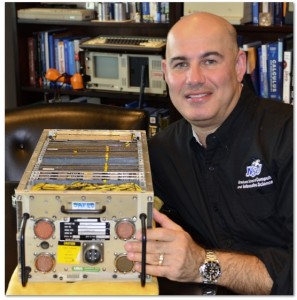NSU Newsroom
SharkBytes
Horizons
This version of NSU News has been archived as of February 28, 2019. To search through archived articles, visit nova.edu/search. To access the new version of NSU News, visit news.nova.edu.
This version of SharkBytes has been archived as of February 28, 2019. To search through archived articles, visit nova.edu/search. To access the new version of SharkBytes, visit sharkbytes.nova.edu.
NSU Receives NASA Space Shuttle On-board Computer for Research
FORT LAUDERDALE-DAVIE, Fla. – Nova Southeastern University’s (NSU) Graduate School of Computer and Information Sciences has received one of the NASA Space Shuttle’s on-board general purpose computers (AP-101S GPC). Faculty and students will study the design and construction of survival systems using the shuttle’s computer.
NSU was selected to receive the computer due in part to the university’s science, technology, engineering, and mathematics (STEM) programs and the Buehler center that will focus on Space-based research. The donation is estimated at approximately $1.2 million. The computer will also be part of an exhibit in 2013 showcased initially at NSU’s Alvin Sherman Library, Research, and Information Technology Center, and then afterward at the Emil Buehler Research Center for Engineering, Science and Mathematics. The exhibit will highlight how computers work side-by-side with man to explore our universe.
“The computer we received most likely flew aboard Space Shuttles Columbia, Discovery, Atlantis, and Endeavour. It is very exciting to have such an important piece of space history at NSU for use by faculty and students to conduct research and inspire young minds,” said Eric S. Ackerman, Ph.D., interim dean of the Graduate School of Computer and Information Sciences.
The computer NSU received was built in 1992 and ran for over 6,000 hours. NSU hopes to inspire young minds to explore STEM careers and bring awareness to the degree programs NSU offers in these areas. The process of obtaining the computer was initiated in 2009 and involved multiple personnel at NASA and NSU.
The space shuttle avionics system consists of more than 300 major electronic black boxes located throughout the vehicle, connected by more than 300 miles of electrical wiring. There are approximately 120,400 wire segments and 6,491 connectors in the vehicle. The wiring and connectors weigh approximately 7,000 pounds, with the wiring alone weighing approximately 4,600 pounds. The total weight of the black boxes, wiring and connectors is approximately 17,116 pounds. The black boxes are connected to a set of five general-purpose computers through common party lines called data buses. The black boxes offer dual or triple redundancy for every function.
The space shuttle used five AP-101s as “general-purpose computers” (GPCs). Four operate in sync, for redundancy, while the fifth serves as a backup running software written independently. The shuttle software was written in HAL/S, a special-purpose high-level language.
The AP-101S GPC has 256,000 32-bit words (roughly equivalent to 1MB of RAM) of CMOS (Complementary Metal Oxide Semiconductor) memory. It uses 550 watts, weighs 29 kilograms (64 pounds), and performs 1.2 million benchmarks per second. It has an MTBF of 10,000 hours, and fits into one box.
The computers control the shuttle from T-20 minutes in the countdown through orbit insertion sequence. All five computers must be in sync and working properly; otherwise, the launch is scrubbed. When the shuttle arrived in space, the crew re-configured the computers for orbital operations. Two GPCs run the on-orbit program, and one GPC is dedicated to payload operations. One GPC is powered down but has the landing program loaded in case an emergency requires the crew to return in a hurry. The final GPC is powered down until needed.
If one GPC fails in orbit (or even two) the mission wouldn’t necessarily have to be aborted if the problem isn’t expected to affect the other GPCs. In theory, any of the five computers has the capability to land the shuttle safely. During reentry and landing, all five GPCs operate together again.
To view photos of the computer, visit: http://www.scis.nova.edu/~esa/ap-101s_NSU.jpg
To learn more about the General-Purpose Computers from NASA please see:
http://spaceflight.nasa.gov/shuttle/reference/shutref/orbiter/avionics/dps/gpc.html
For more information about NSU’s Graduate School of Computer and Information Sciences, visit: scis.nova.edu
For more information about the Emil Buehler Research Center for Engineering, Science and Mathematics (EBRC), visit: www.nova.edu/buehler
About Nova Southeastern University: Located in Davie, Florida, Nova Southeastern University (NSU) is a dynamic fully accredited Florida University dedicated to providing high-quality educational programs of distinction from preschool through the professional and doctoral levels. NSU has more than 28,000 students and is the eighth largest not-for-profit independent institution nationally. The University awards associate’s, bachelor’s degrees, master’s degrees, specialist, and first-professional degrees in a wide range of fields, including business, counseling, computer and information sciences, education, medicine, optometry, pharmacy, dentistry, various health professions, law, marine sciences, early childhood, psychology and other social sciences. Classified as a research university with “high research activity” by the Carnegie Foundation for the Advancement of Teaching, NSU was also awarded Carnegie’s Community Engagement Classification in 2010 for the University’s significant commitment to and demonstration of community engagement. For more information about NSU visit www.nova.edu.
# # #
Media Contact:
Brandon Hensler, APR, NSU Office of Public Affairs
office (954) 262-5385, cell (954) 393-5926, or e-mail: brandon.hensler@nova.edu
